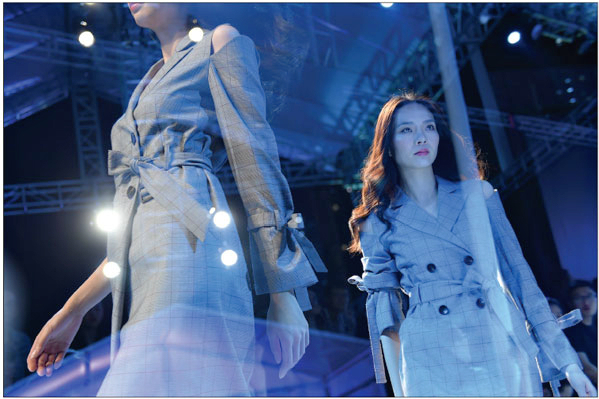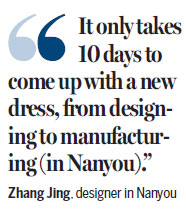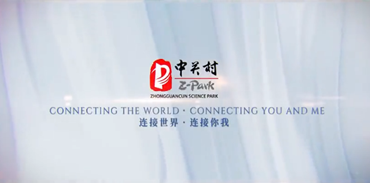Clothing pioneer Nanyou fights for its name
 |
|
Models trot the catwalk in a Nanyou mall in May, showcasing the latest garments made by local designers. Aspiring designers from around the country have been fl ocking to the Shenzhen clothes market to take advantage of its complete industrial chain. Provided to China Daily |
Shenzhen clothes hub rejuvenates with push to keep original design trademark alive via innovation
From the first foreign investments to the heyday in manufacturing, Nanyou - a rather cloistered place tucked away in Shenzhen's western Nanshan district - has testified to the city's tremendous economic transformation since the country's reform and opening-up.
Nanyou still stands as one of the nation's largest distributing centers for middle- and high-end clothes, embracing a complete industrial chain from clothing materials, manufacturing and designing to retail.
Its nearly 40 shop buildings keep teeming with couriers on their toes, wrapping up and hauling carts of packages containing the trendiest high-waist trousers and one-piece dresses, as pretty models take snapshots for online clients.
With a history of almost four decades, the Nanyou clothes market is rejuvenating itself as a center for designer brands with innovation emerging as the primary force in propelling growth in Shenzhen and nation-wide.
However, being creative is never an easy job. Local designers are struggling to make ends meet while pursuing their dream to trademark their names.
Industrial zone
Nanyou's first industrial zone sprang up in the early 1980s as China threw open its doors to the outside world in 1978, and it has been processing materials for global garment brands for decades.
Gradually, some manufacturers began selling their stocks on the first floor of their factories, eventually giving rise to the clothes market. As these products were at the forefront in the fashion trend and were of high quality, vendors started distributing them to other cities.
Li Ding, who had worked at the iconic Century Plaza shopping mall in Nanyou for seven years, recalled: "At its peak in Century Plaza, a store's leasehold could change hands for 8 million yuan ($1.2 million), and the monthly rent was about 1,300 yuan per square meter".
The figures were even higher than those at Shenzhen's famous Huaqiang North electronics market. According to Li, these almost amount to a retailer's entire profit for one year, and it would need an extra 500,000 yuan just to change the owner's name.
Due to the unbelievably high costs, traders began expanding to neighboring buildings, and the clothes market has grown from the original 12 factory buildings to the present some 40.
Innovative upgrade
But, the Nanyou market used to be piled up with knock-off products - the same problem that plagued Huaqiang North market.
Many store owners bought international luxury brands' dresses and asked local factories to copy the exact pattern and design using the same materials.
In the past, such a business model had been prevalent, "but now it's not what we're trying to develop," commented a Shenzhen city official surnamed Chen. He revealed that the district government is looking to renovate and update the Nanyou market.
In 2014, Shenzhen was approved as a national innovation demonstration zone, highlighting innovation-driven, high-end technology and emerging industries. The city is now going through the second-stage reform - a revolution to upgrade itself from being the world's factory to China's Silicon Valley.

Li Ding spotted the new trend and decided to launch his own shopping center nearby, specializing in just original design brands.
The monthly rent at Li's mall is 280 yuan per square meter - the lowest for the whole market - he said.
So far, Li has introduced about 130 designer brands, representing thousands of designers, and the revenue of each tenant has gone up to 20 million yuan on average per year, he said.
More than 200 brands are queuing up to move in. But Li doesn't want the shopping mall to turn into a property speculation target, so he needs to make sure that tenants are genuine clothes designers before renting out shops to them, and sub-leasing is strictly forbidden.
What attracts them is not just the low rent, but also Li's resolution to avoid knock-offs. Derivative designs will be taken down and the tenant would even be forced to move out.
"So far, no one has been asked to leave for being a copycat," said Li.
Original dream
There are about five buildings in Nanyou housing original design brands and Shenzhen's original design has now made a name for itself.
Nanfang Daily reported that about 60 percent of high-end clothing sold at more than 100,000 shopping malls in the country's first-tier cities is made by Shenzhen designers.

Xie Haiping, a prominent designer who has held his own shows during the New York and London fashion weeks, opened a collective store for designer brands at Nanyou, aimed at pushing the development of original design in the industry.
However, many designers in Nanyou are still striving to survive. Among them is Zhang Jing, who entered the market as an OEM (original equipment manufacturer) supplier in 2011.
She recalled having picked the location because every process in clothes making could be completed at the Nanyou market. "It only takes 10 days to come up with a new dress, from designing to manufacturing," she said.
Zhang resorted to supplying clothing to major domestic brands, but she wasn't holding the aces when it came to negotiating prices, not to mention the high rents and labor costs that have grown exponentially.
So, she decided to build up her own brand - MST - in 2015. In just three years, her designing team had grown from five people to 15, with net profit per piece rising from 30 yuan to 80 yuan.
But, she still finds it difficult in taking on the larger brands, so she has to turn to OEM to eke out a living.
Zhang aspires to produce a 100-percent original brand, but now she still has to sell 10 percent of her products to other conventional brands.
Another problem she's confronted with is to keep innovating. "More and more designers from all over the country are coming to Shenzhen, to Nanyou, so it's easy to become homogeneous," she said, adding that she makes more than 500 patterns each year.
grace@chinadailyhk.com

